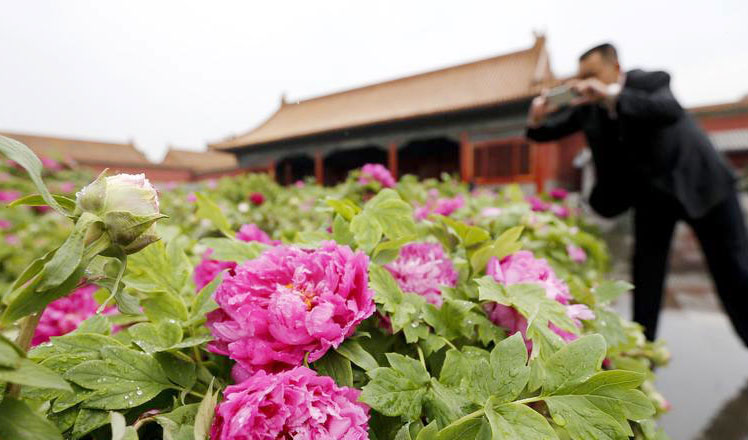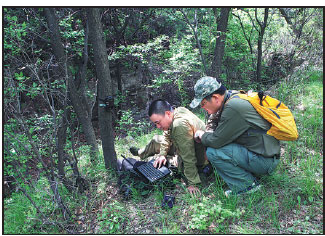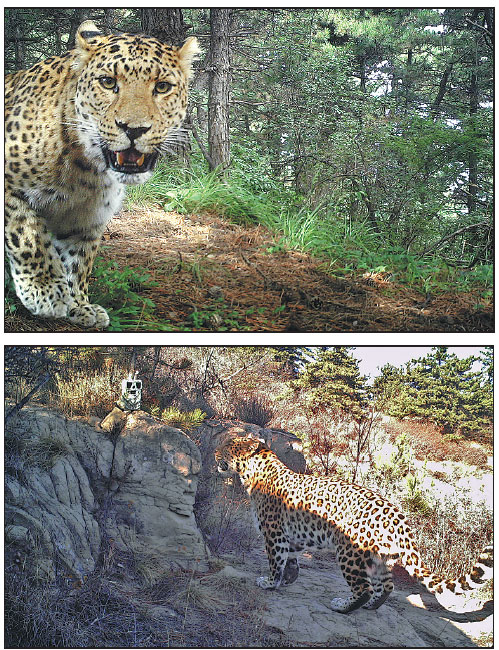Small group claws its way up
Updated: 2016-03-25 07:57
By Xu Lin(China Daily USA)
|
||||||||
In 2008, the Chinese Felid Conservation Alliance began building a camera-trapping network to monitor North Chinese leopards in Shanxi province. Today, it says there are more than a dozen members of the species in the area. Xu Lin reports.
In the first scene you can see two leopards walking past in a mountain forest. Then, one pauses after it notices something - an infrared camera. It claws at it several times until it falls off its mount.
This is among the scenes captured by more than 100 infrared cameras in the central Taihang Mountains in Shanxi province.
In 2008, the Beijing-based Chinese Felid Conservation Alliance began to build its camera-trapping network there to monitor North Chinese leopards in an area covering about 300 square kilometers.
"Leopards are awe-inspiring and pretty animals. It's not difficult to film them, but what we want is for them to live unharmed and for their habitats to be protected," says Song Dazhao, 39, cofounder of the nonprofit organization.
In 2011, the CFCA and a biodiversity research team of Beijing Normal University started a monitoring program for the leopard population there.
It was the first research project on the subspecies that's native to China.
The project aimed to study the animal and figure out ways to boost the leopard population in China.
In May 2014, the cameras captured a female leopard and the researchers wondered whether it was pregnant.
About half a year later, they were excited to see the leopard again, together with two cubs.
"We love big cats. And when we see cubs we feel that what we are doing is worth it," says Song.
Leopards are solitary animals and seek courtship only during breeding season.
But their monitoring has begun to reveal other sides to the animal.
According to Wan Shao-ping, director of the North Chinese leopards project at the CFCA, the leopards like to lie on their backs with their legs in the air and enjoy the sunshine. They love playing with twigs and the males typically fight each other for territory.
Cubs are usually born in a litter of two in April or May, and become independent when they are around a year old. Their main prey are roe deer and wild boars.
As of now, the CFCA has only six members and they are together because they love nature and big cats.
So how do they prepare for a project?
For starters, they begin by observing the landscape and the vegetation of the area to learn about the habitat via Google Earth.
Then, they visit villages nearby to rub shoulders with locals and gather information about the leopards.
Finally, they go into the mountains to collect evidence such as feces and footprints of the animals to decide where to place the cameras.
In the past few years, the CFCA found evidence that there were more than a dozen leopards in the area.
Although the CFCA is striving to help protect the leopards, Wan and Song regret that while they have seen many wild animals they have never spotted a leopard.
The closest they came to seeing one was once when they had just finished setting up an infrared camera.
A leopard appeared at the spot soon after they had left the area and peered into the camera curiously.
"As the king of the woods, it (the leopard) is aware of everything happens in its dominion," says Wan.
Despite its small numbers, the CFCA does not let size come in the way of its ambitions.
As of now, they have hired five locals in Shanxi to promote the importance of protecting leopards, to patrol the mountains, to collect data regularly from infrared cameras and report poachers to the police.
"Our members often go into the mountains and they have seen leopards several times. Nothing dramatic happens when they spot the animals because leopards typically don't attack human beings," says Wan.
"But leopards do prey on livestock. So it is urgent to tackle this conflict to avoid someone poisoning the leopards in revenge."
In 2013, the CFCA started to investigate the loss of cattle in Shanxi province and launched a compensation program last year.
There were 44 confirmed cases of livestock loss and they paid out a total of 64,000 yuan ($9,700).
When a villager reports a cattle death, the CFCA's local members confirm whether it has been attacked by a leopard.
The standard compensation is between 800 yuan and 3,000 yuan depending on the animal's weight, but it's just about a fifth of what the animal is really worth.
"It's only a psychological comfort. The farmers are honest and impoverished, and most of them support what we're doing," says Song.
According to him, though the government has built cattle pens in the village, farmers prefer to leave their cattle on the mountains most of the time.
And though grazing is prohibited in the area it's not easy to keep farmers from accessing the site as farmers save money by letting the animals graze on the mountains and it also gives them time to do other jobs.
"It (the issue) is complicated. And, while compensation is not a lasting solution, our final aim is to work with the local government to get all the cattle out of the mountains, or establish a fenced grazing area," says Song.
In 2015, the CFCA's investigations in a village in Sichuan province showed more than 40 heads of cattle and horses had been killed by leopards.
The area where the animals were said to have been killed is legal grazing ground so the CFCA plans to work with the government to have a pilot compensation project introduced there.
Shedding more light on the big cat-livestock issue, Feng Limin, a big cat expert from Beijing Normal University and cofounder of the CFCA, says: "Research shows that leopards are resilient to human-dominated landscapes and are restoring their population in the remaining temperate forests in North China."
His research team has also conducted more than 10 years of research on the Amur tiger and Amur leopard in Northeast China.
The Amur leopard is one of the most-endangered of the nine leopard subspecies in the world.
But the university’s research shows that the animals' population is recovering and there were at least 42 Amur leopards spotted in the wild in 2014.
With regard to the falling number of tigers and leopards in China, Feng attributes this mainly to loss of habitat, degradation of the prey population and poaching.
But he says recent evidence shows that the number of big cats, such as tigers and leopards, is growing thanks to efforts to connect habitats and ensure minimized human disturbance in those areas.
Looking to the future, Feng says that it is urgent for us to collect information about the status of leopards and their population in China and identify key habitats for conservation.
There should also be a well-planned strategy based on scientific research.
Explaining why this is key, Song says that often the habitat may involve different owners and overlapping jurisdictions. Also, each area may have different policies with regard to conservation.
The CFCA recently launched a crowdfunding project to raise funds for its campaigns and offered to give donors photos, videos, badges and magnets of leopards, and even offered a field trip to their project area.
There's no stopping these eco-warriors it seems as they resort to every trick available to save the leopard.
Contact the writer at xulin@chinadaily.com.cn
|
Song Dazhao (left) and Wan Shaoping observe the landscape and the vegetation of the area to learn about leopards’ habitat via Google Earth during a field trip. |
|
Images of wild leopards are captured by infrared cameras in the Taihang Mountains in Shanxi province. Photos Provided To China Daily |
(China Daily USA 04/13/2016 page10)
- Brazil commission recommends impeachment against Rousseff
- Severe storms rage through southern US states
- DPRK to participates in Paris climate signing ceremony
- Canadian PM to apologize for rejection of Sikh people in 1914
- Envoy to Middle East covers a lot of ground
- India detains 5 as temple fire kills 112

 3D printers from China at New York show
3D printers from China at New York show
 UN takes historic step to open selection of new UN chief
UN takes historic step to open selection of new UN chief
 Palace Museum stages peony-themed exhibition
Palace Museum stages peony-themed exhibition
 Man abducted 19 years ago reunites with family
Man abducted 19 years ago reunites with family
 Now and then: Technologies improve media work
Now and then: Technologies improve media work
 Unforgettable wedding photos at fire station
Unforgettable wedding photos at fire station
 Jack Ma toasts wine with Italy's prime minister
Jack Ma toasts wine with Italy's prime minister
 Top 10 best airports in the world
Top 10 best airports in the world
Most Viewed
Editor's Picks

|

|

|

|

|

|
Today's Top News
Duke alumni visit Chinese Embassy
Marriott unlikely to top Anbang offer for Starwood: Observers
Chinese biopharma debuts on Nasdaq
What ends Jeb Bush's White House hopes
Investigation for Nicolas's campaign
Will US-ASEAN meeting be good for region?
Accentuate the positive in Sino-US relations
Dangerous games on peninsula will have no winner
US Weekly

|

|

